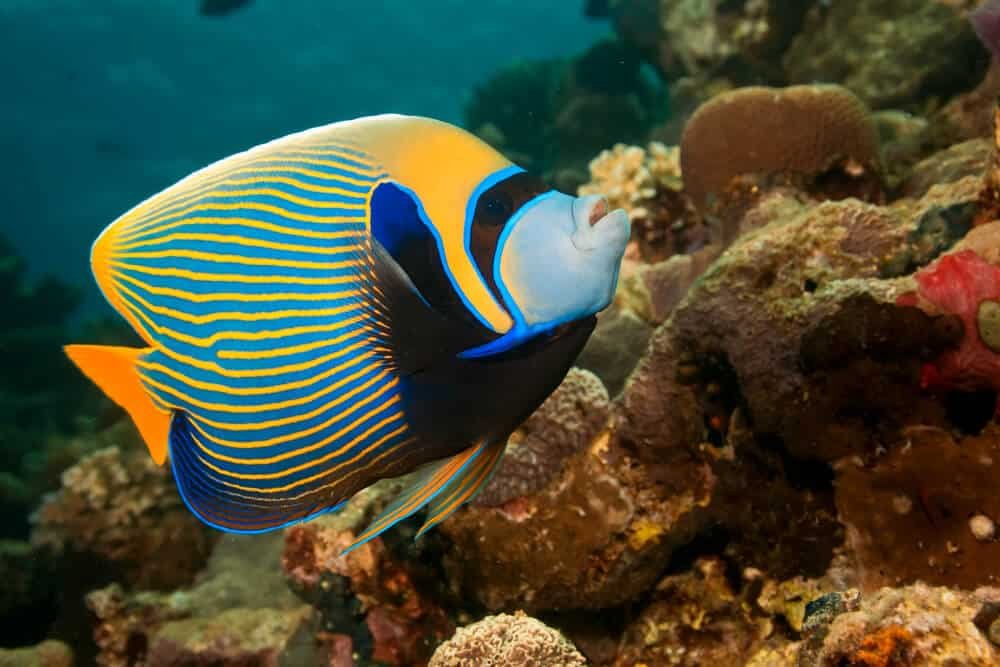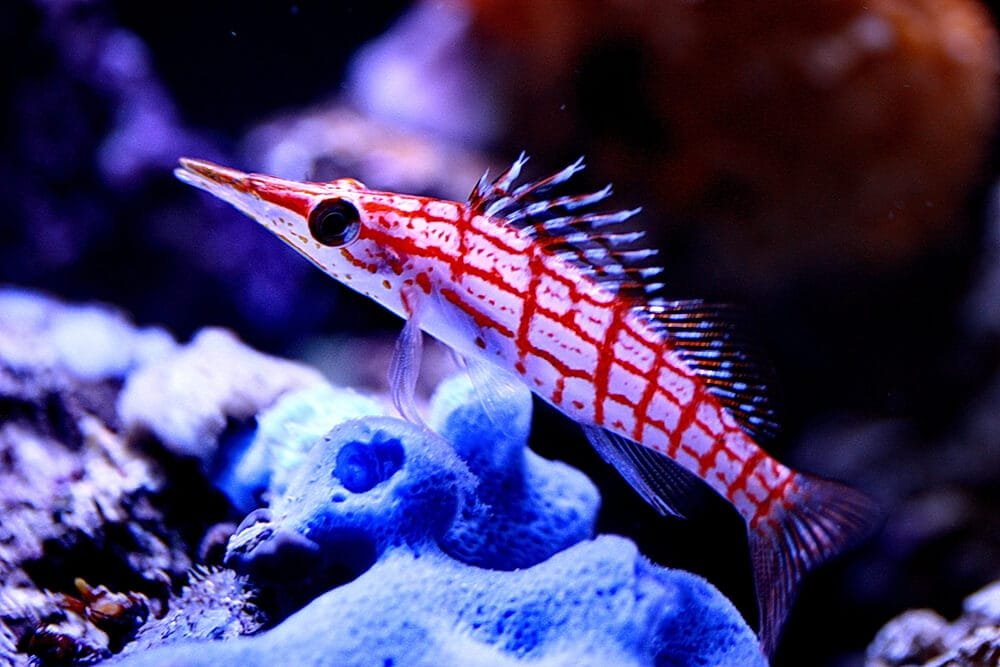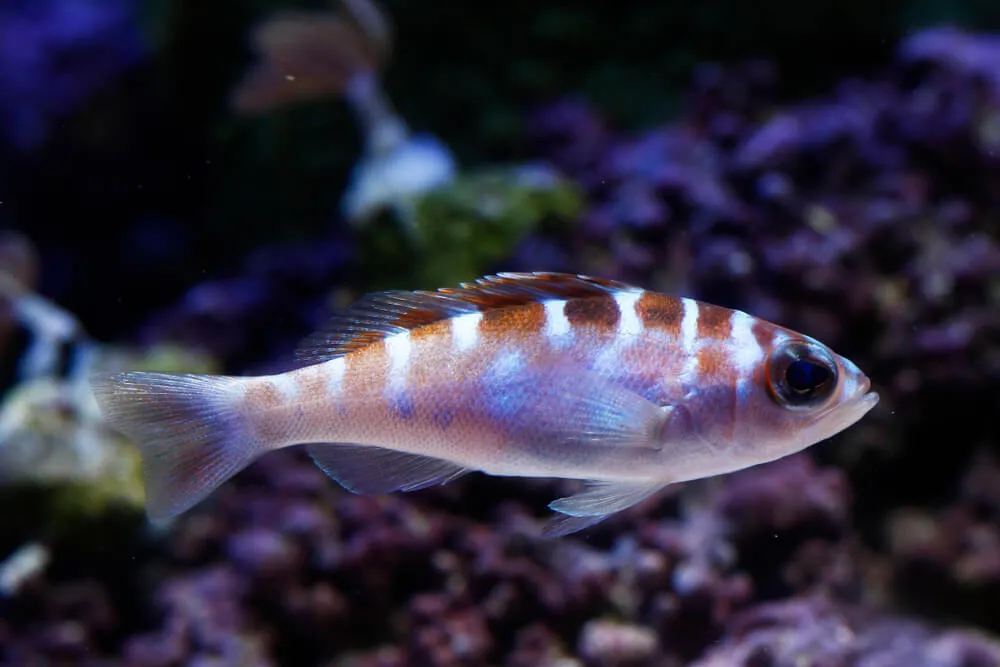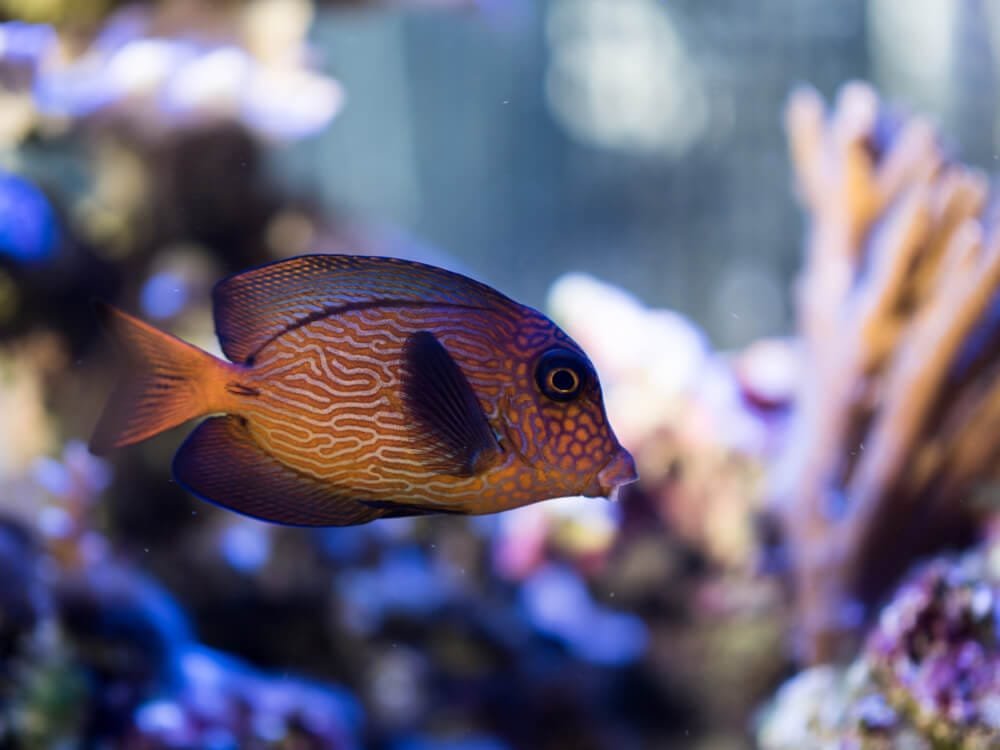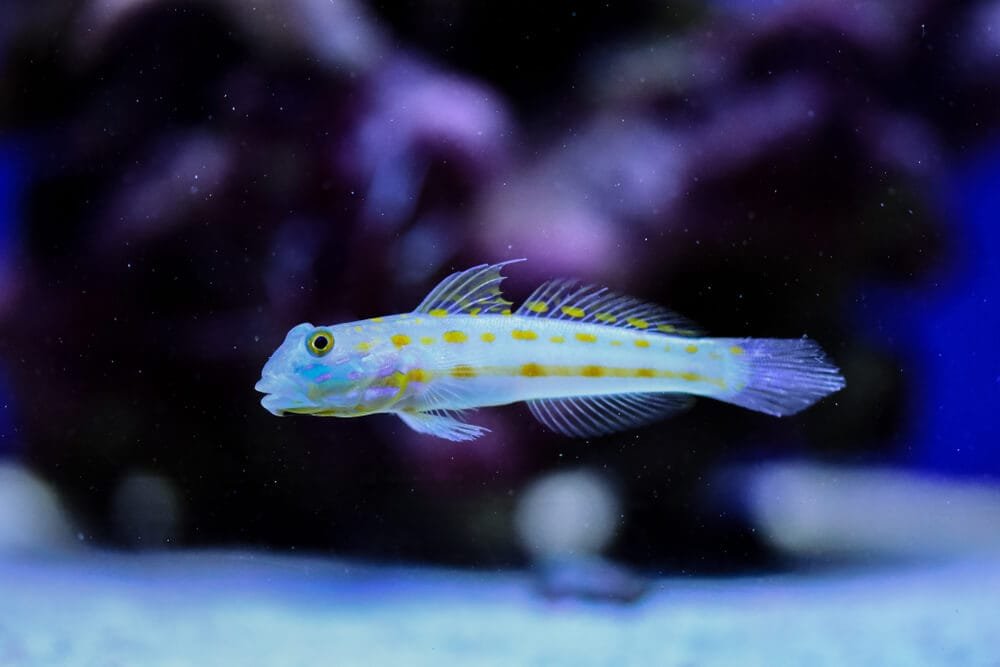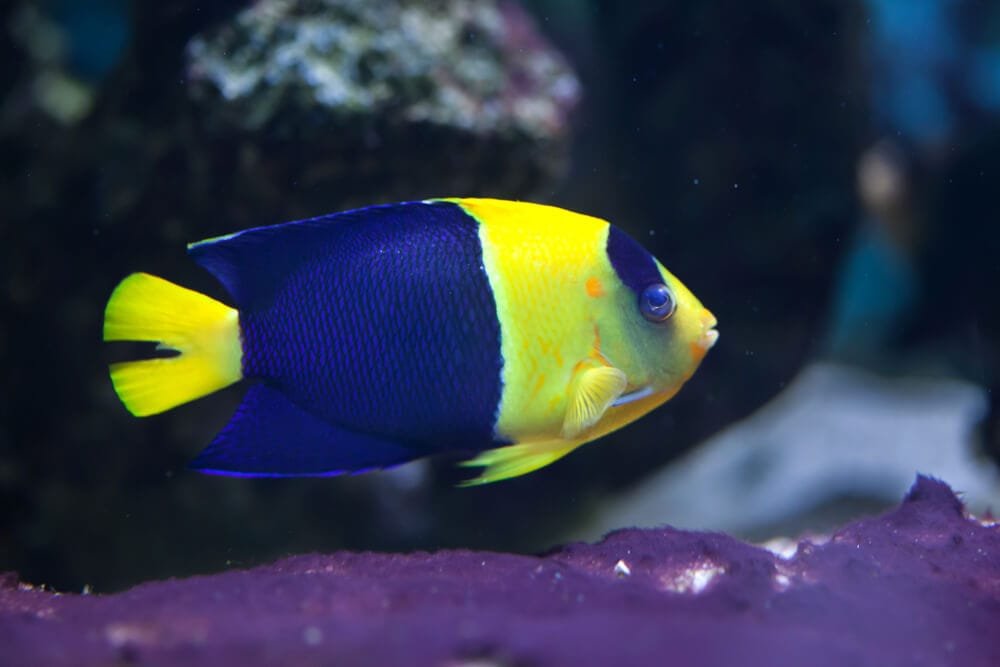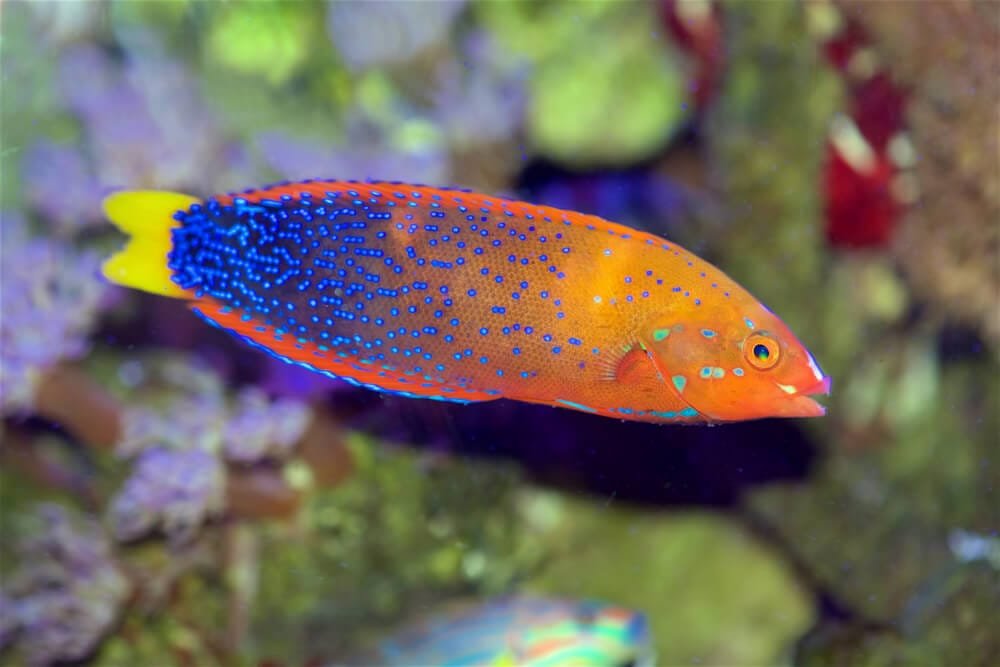Royal Gramma Care Guide 101
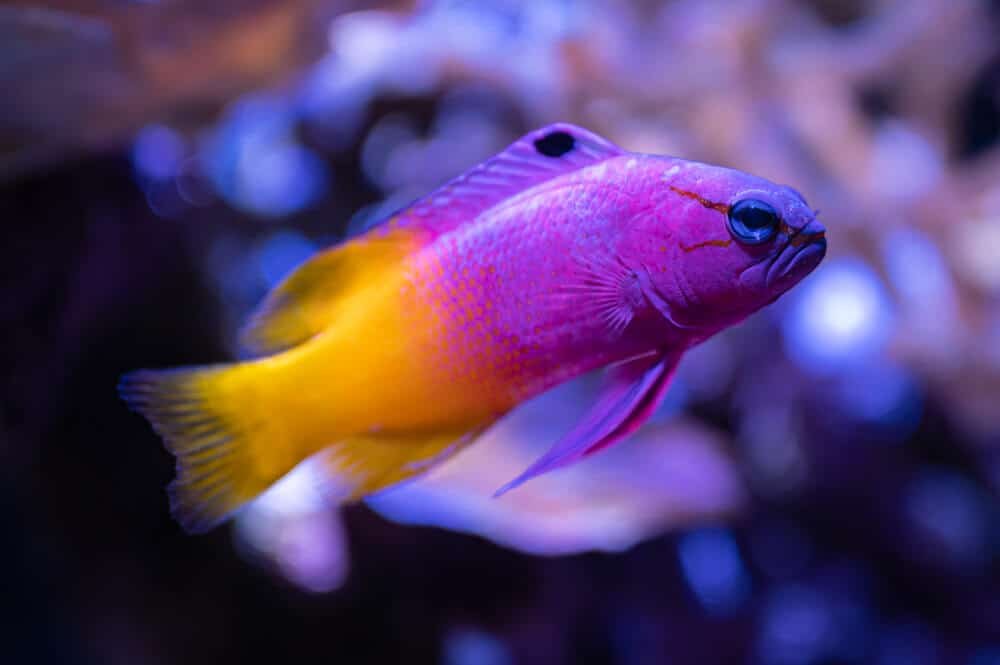
Species Overview
Common names: Royal gramma fish, Fairy basslet
Scientific name: Gramma loreto
Adult size: 3 inches
Life expectancy: 5-6 years
Characteristics
Family: Grammatidae
Origin: The Caribbean, Tropical Salt Waters of the Atlantic Ocean
Social: Community
Minimum tank size: 30 gallons
Diet: Carnivore
Breeding: Egg carriers
Care: Easy
Ph: 8.1 to 8.4
Hardness: 8-12 KH
Temperature: 72-80 F
Have you been looking for a perfect fish species to add to your community tank? This fish makes a perfect addition to a saltwater aquarium.
With its sparkling purple and yellow body, the fish species provides an exceptional color making it a very attractive fish to keep in your aquarium.
The Royal Gramma fish is low maintenance, peaceful and friendly to beginners making it ideal for your tank.
Most aquarists favor this fish species because it’s easy to care for and reef compatible.
This article provides you with a guide on everything you need to know about this fish species. You will learn about the requirements and interesting facts about this fish. Read on to understand more.
Royal Gramma Overview
These fish species are little treasures found in the Caribbean waters. They have dynamic color changes on their scales. They are peaceful and hardy making them superb for all aquarists.
The fish grows to a length of up to 3 inches. Its head is bright purple, and its tail area fades to neon yellow.
Although these fish have an accessional territorial behavior as they defend their reef place, they are known to be peaceful as they rarely cause problems.
Note that, setting up a marine water tank has higher maintenance than freshwater tanks.
It is recommended to have a little bit of experience with freshwater fishkeeping before engaging in saltwater aquatic.
Origin and Classification
This fish species is native to the reef environment of the tropical waters of the Caribbean. They are also found in the tropical western Atlantic Ocean, Central America and South America.
The small and colorful saltwater fish has a common name, Fairy Basslet, and a scientific name, Gramma Loreto. It is from the Grammatidae family which comprises ray-finned fishes.
In the wild environment, the fish live between 3 and 60 feet in depth inhabiting the reefs and coral outcrops where they swim upside down. The fish is still abundant in the wild.
Appearance and Size
One of the unique qualities of this fish species is its coloration. The fish is a real stunner and is a specie that many aquarists dream of having in their community tank.
The front half of its body is purple and blends with a golden yellow shade towards the end of its tail. In the middle of the fish body where the colors collide, there are a series of dots on each individual making each fish species unique.
This fish is small and grows to a length of three inches. With their small size, it will be easy for you to fit them in the aquarium.
Determining the sex of the fish is a challenge as they are all born females. However, as they grow the dominant fish will change its gender and become a male.
The male colors are more vibrant than the females. Also, males are large with bigger ventral fins than females.
You may confuse this fish with the Royal Dottyback since they are similar. However, Dottyback is aggressive and less compatible with other fish species. Also, the Dotty back body has no color blending.
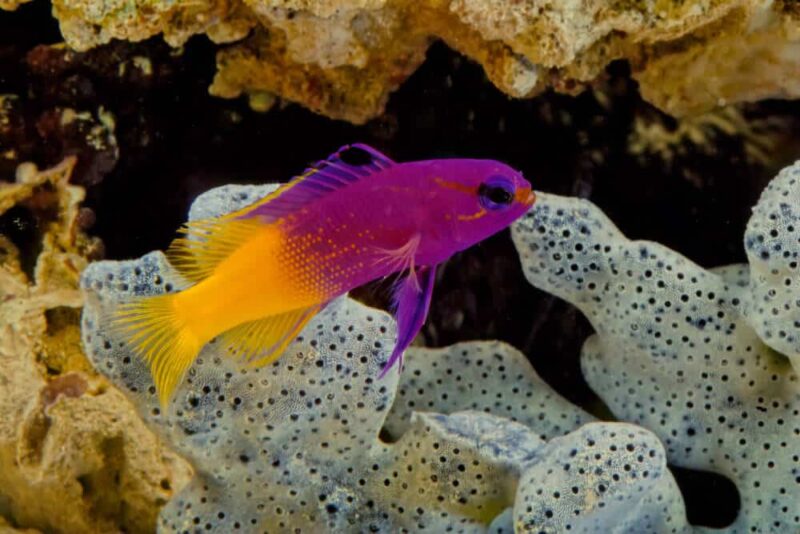
Habitat
The fish is a saltwater fish that loves to live in deep water reefs. It feels comfortable when surrounded by rockwork like corals, reefs, caves, outcroppings, and overhangs in dull lights.
They prefer remaining in this rockwork since they are not good swimmers.
Availability
You can easily find this fish in aquarium stores or online. Nevertheless, be careful when buying fish online.
Look for a seller with a good reputation who will ensure the fish is healthy and handled properly while in transit.
The price of the fish will depend on the size of the specimen, but they do range between $30 and $40. If you buy the fish online, you will be required to add the shipping fee.
Behavior and Temperament
Many people tend to ask if this fish is aggressive. Royal Gramma is not aggressive and is, in fact, one of the most peaceful fish species to have in your community tank.
By nature, this fish is shy and calming. Nonetheless, if they find their tank mates are invading their home space, they get upset and react. This fish and Royal Dottyback are rivals, and you should avoid putting them together.
The fish is known for its high jumping despite its small size. If your aquarium has no lid, the fish may jump out of the tank especially if they are new to the aquarium.
This fish is known to swim upside down under hard surfaces and hang upside down. So, if you find it facing upside down there is no cause for alarm.
Lifespan
It has a lifespan of between 5 to 6 years. Their lives are determined by the type of care they receive. They can last longer than 6 years if the aquarium conditions are of high quality.
Their lifespan is shorter in the wild because of attacks by predators and other environmental factors.
Care and Maintenance
Caring for this type of fish is very easy. All you need is the right tank, the correct tank setup, and its preferred water conditions.
This fish is therefore ideal for aquarists beginners since it’s simple to look after them. They adapt and easily thrive in a well-maintained aquarium.
When breeding small saltwater species like this fish, the most essential things to be properly managed are food and living conditions. Following all the requirements allows your fish to remain stress-free and live longer.
Tank setup
It is recommended to recreate their natural habitat when setting up the tank for their survival. Here are factors you should consider when setting up the tank:
Suitable plants
The tank of this fish should be set up with saltwater plants, corals, and reefs. This fish loves overhanging plants. You can also add artificial plants to offer hiding areas for the fish species.
Some of the aquarium saltwater plants you can use include:
- Sea Grass
- Red Grape Algae
- Halimeda
- Red Bush Gracilaria
Tank size
The minimum tank size for this fish is 30 gallons which will allow enough space for the dense and rocky aquascape they like. If you want to put a pair of these fish, the optimum tank size should be 50 gallons.
Ensure you look for a water tank with a lid to prevent them from escaping because these creatures love to jump.
They prefer living alone in the tank and may get aggressive or put together with other members of the species.
Water parameters
Due to its hardy nature, the fish can live comfortably in water conditions of fair range. The fish loves waters with a temperature of between 72 to 80 F. The PH levels range between 8.1 to 8.4 with an 8 to 12 KH carbonate hardness.
You should be cautious and ensure that the aquarium doesn’t get into an alkaline state by having a weekly test.
The fish prefers a clean habitat; therefore, make sure to use a power filter. Poor water quality can lead to the death of your fish.
Substrate
This fish loves being in deep water reefs. Ensure you add caves, rocks, and cavities for them to retreat and hide.
Also, add sand to act as the natural substrate that prevents them from injuring their fins while looking for food.
Tank decoration
As you decorate the tank, try to maintain the natural habitat of the fish. It will allow the fish to settle fast, encourage feeding, prevent stress, and keep disease outbreaks away.
For this fish species, design a deep-water reef tank with sand substrate and decorate the tank with live rocks, crevices, caves, and nooks where it can stay.
Lighting
This fish does not need bright or harsh lights in the tank. Its natural environment light is dim.
When lighting the tank, consider dim lights. The fish coloration is well displayed and saturated when the lights are dim making the aquarium beautiful.
Filter
Ensure the water tank has a filter that will help in filtering the water pollutants. In addition, this filter can bring high flow in the aerated water of the tank.
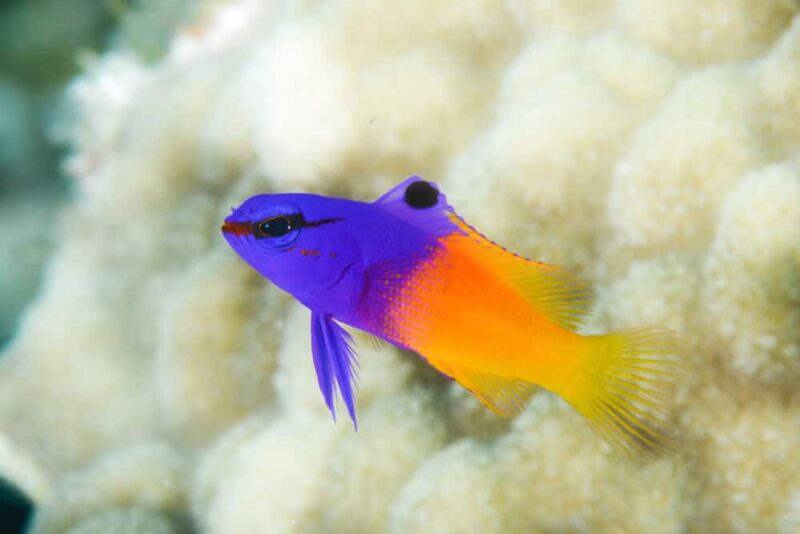
Tank mates and compatibility
This type of fish is a great community fish and can be a perfect addition to saltwater aquariums.
Compatibility involves fish of different species living together without harming one another. It is a result of them having the same dietary requirements and avoiding invading others’ territory.
Compatibility promotes good health for both fish species in the tank. This fish has good compatibility but due to various reasons conflict may arise.
When choosing tank mates consider the following types of fish:
- Fish that are not aggressive. This fish is peaceful and would make a great tank mate to others that are non-aggressive.
- Fish that are not territorial. Since this fish is very territorial and loves its space, look for a tank mate without these characteristics to prevent chaos from arising.
- Fish with the same body coloration. If you choose a tank mate with the same body color, they will clash if kept in the same aquarium.
- Other fish species not of their family. Putting several of these fish in the water tank is dangerous because they fight to have the same water tank items. Especially males who are more notorious.
Avoid putting them in water tanks in groups, each specimen should have its tank to prevent them from fighting over territory.
If you want to put a pair, you should pair a male and a female and get enough space with more rockwork to design their territories.
Examples of ideal tank mates for this fish include:
- Angelfish
- Boxfish
- Filefish
- Clownfish
- Hawkfish
- Rabbitfish
- Gobies
- Jawfish
Unsuitable tank mates
This fish gets aggressive when other fish species intrude into their hiding spaces. Do not put other aggressive and larger fish in the water tank that can injure these fish. Unsuitable tankmates include:
- Lionfish
- Eels
- Line wrasse
- Red scooter blenny
- Snappers
- Shark
Breeding
This fish species is one of the easiest to breed when in aquarium conditions. You only require a little experience to breed this fish. Their breeding happens over the warmer months of the year.
Below are steps on how you can breed the fish in the tank:
- Put enough rocks and plants to allow them to cave out of their nesting areas.
- Ensure the water characteristics are stable. It should be less acidic.
- The temperatures of the tank should remain between 72 and 80 F.
- Once the female lays eggs and the male fertilizes them, remove the adult fish and return them to the community tank. Keep an eye on the eggs.
The fertilized eggs hatch within a week in the evening when light conditions are low. Initially, feed the baby fish species small bits of food. As they grow, introduce bigger bites that can fit in their mouth.
Diet and Feeding
In the wild, this fish species feeds on zooplankton and phytoplankton. They are known as cleaner fish because they tend to feed on parasites that are on other fish’s scales.
It results in a symbiotic relationship which is a benefit to both species.
In the aquarium, the fish will feed on small meaty foods like mysis or brine shrimp.
Also, they feed on dead food such as crustaceans and fish flesh from other fish in the tank thus maintaining the environment. They are classified as carnivores.
To keep this fish healthy and happy at all times, keep them on a steady diet of brine shrimp and mysis shrimp.
Give them a wide variety of foods and rotate their diet to keep them happy. They can work with any feeding schedule since they are small hardy fish.
Ensure you feed them a few times a day even when they are in their hiding places. Once they notice food is available, they will dart from their hiding spot to get the food.
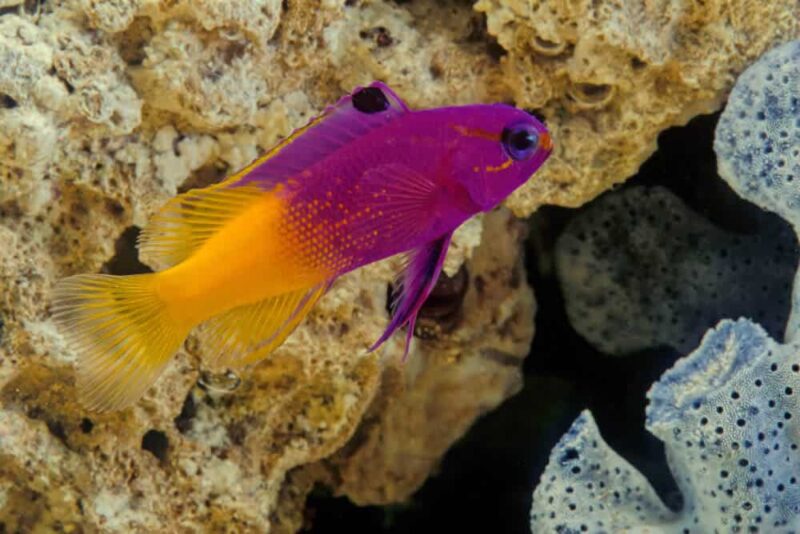
Common possible diseases
This fish is a resilient fish that is not subject to complicated conditions, especially when the conditions of the aquarium are good.
If you ensure the water in the tank is properly maintained, the fish can live for a long term without catching any disease.
However, since it consumes parasites, it can be affected by various infections which include:
Fungal infection
These infections can be a major problem for this fish species. It leads to skin discoloration and other health complications.
Ich
The fish will have white spots and loss of appetite. If the fish has ich, it’s taken to quarantine and treated with antibiotics.
Bacterial infection
This infection is common to most fish species. It has symptoms such as mouth rot, fin rot, and ulcers. They can be treated using antibiotics.
If these infections are left untreated they can lead to complications or death.
If you notice your pet fish has no appetite, consistent seclusion, coloration, and scales indentations, then consult your veterinary doctor right away.
As long as you keep the water conditions and no fish species are stressing this type of fish, it will remain healthy.
Disease treatment
These fish species’ diseases can be controlled with chlorine or antibiotics. To keep them healthy and avoid getting sick, feed them with a balanced diet and change the tank water regularly.
In case of any symptoms such as loss of appetite, report to a qualified veterinarian for diagnosis and treatment.
Benefits of this Fish
Royal Gramma offers various benefits to most people compared to other fish species. There are reasons why most aquarists prefer having them:
- They have a beautiful and vibrant appearance that attracts visitors.
- They are peaceful and can live well with other species making them suitable for community fish tanks.
- The fish species are hardy and resilient making them resistant to most diseases affecting fish species.
- They can feed on dead flesh such as the crustacean thus the benefits of maintaining the environment.
- They promote symbiotic relationships by feeding on parasites on the scales of other fish species.
Disadvantages
- Some people may opt for other fish species because of the following reasons:
- Setting up a saltwater aquarium is expensive, also the purchasing price of this fish is quite high.
- The fish is known for jumping and may escape.
- It is aggressive to its kind.
- It can be territorial when invaded by other species.
Frequently Asked Questions
Should you get this fish for your aquarium?
Yes. They are easy to care for and maintain. Their vibrant and beautiful appearance makes them liked among aquarists.
How many fish species of this type should you have in the tank?
It is recommended to have one of these fish. Having several mature fish in an aquarium can lead to aggressive behavior.
Nonetheless, if you have two of these fish species, they can live together peacefully if you provide them with enough swimming areas and hiding places.
Is this fish aggressive?
This fish is typically calm and shy. They don’t show aggressiveness unless forced by environmental conditions. For example, if you put them in a tank with poor water conditions, they will get agitated.
Also, if their tank mates are aggressive enough to invade their hiding spots, they will get irritated and tend to react.
How long does this fish species grow?
This fish grows to about 3 inches. They are a small type of fish compared to other species.
How long does this fish live?
The fish has a lifespan of between 5-6 years. Their lifespan depends on various factors such as quality of water, diet, and aquarium conditions. The fish will live longer or shorter depending on how these factors are provided.
To ensure your fish live a long and healthy life, consider providing it with optimal care and maintenance.
Do these fish jump?
Yes, they jump. The fish prefers deep water reefs and love hiding in their favorite spots. They only jump because they cannot swim properly.
Therefore, make sure to secure your water tank with a lid to prevent them from jumping outside.
How long will these fish hide?
The fish is known for its shyness and prefers hiding under driftwood, rocks, reef, corals, and caves. They can even remain hidden for 4 to 5 days.
If you have this fish species in your aquarium expect to see it hidden for about a week.
Can this fish live together with its kind?
Yes, it can. However, you should ensure the water tank size is 50 gallons to create enough room for more rockwork. It allows each fish to create its territory.
Also, avoid putting them if they are of the same gender, pair a male and female to prevent aggressiveness.
Conclusion
This fish is a must-have fish species for those planning to start a reef aquarium. If you are new to saltwater fishkeeping, it will be a smooth experience for you when you have this fish as your first water tank creature.
Compared to other fish species, this fish is becoming popular among expert and beginner aquarium owners. This is because they have a unique and vibrant appearance and a peaceful temperament.
They prefer living in water tanks with similar conditions as their natural habitats. So, it has to add live plants, rocks, driftwood, substrates, and rocks.
Taking care of and feeding these fish species is relatively easy. All you need is to ensure they have conducive living conditions and they are maintained regularly.
This fish is a great addition to any aquarium and would make a good pet. If you are thinking of investing in fish species or have a pet, you can never go wrong with this fish species.
Will this fish be a worthy addition to your water tank? It’s up to you to decide. Nonetheless, this fish is liked by many people in the aquarium world. Start raising some and you can also get to enjoy the benefits.
